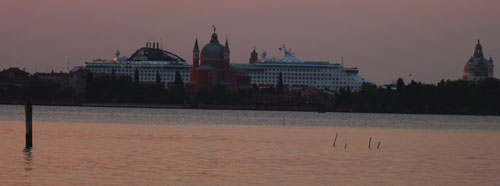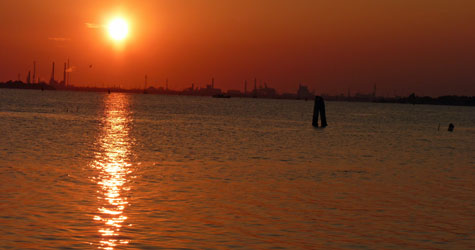 |
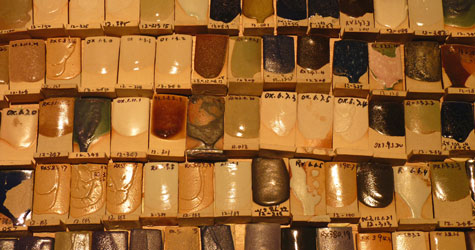 |
|||
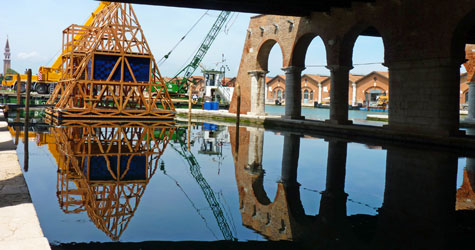 |
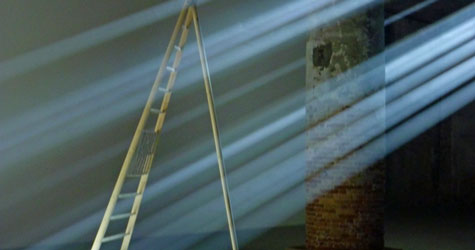 |
|||
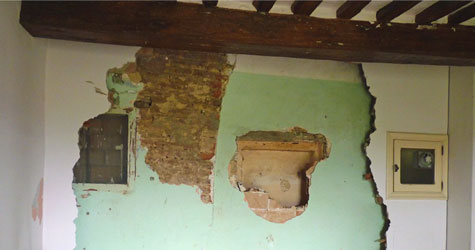 |
 |
|||
31 May 2016
The other morning, in a snazzy hotel on a Venetian island, I woke up screaming, which is something I can’t remember ever having done before. L confirms.
In my dream I was wandering along the top-floor corridor of a house that was ‘ours’ though it only bore a passing resemblance to the real thing. I was with two CdP friends, chatting. Our neighbour was going past, further up the lane, on his tractor. My friends referred to him as Giuseppe (a brilliantly talented local earth-mover) rather than by his real name, Fabio (someone who is well known to hate anything to do with the countryside). This information is irrelevant.
Suddenly I noticed that the stone garden walls descending towards the lower floor of the house (made, in my dream, of the Cornish slate that one of my childhood homes was built out of) had collapsed, as if an immense weight had crashed down them. When I went downstairs, the whole lower floor was a jumble of masonry, smashed to smithereens by some unseen force.
At which point I woke up. Screaming, as I said. I spent quite a while trying to work out what brought the dream on.
It was, I’m sure, partly guilt at my over-ambitious spring and early summer timetable, with far too many days of travel planned for someone who not only has her own demanding garden to tend, but also has a whole pile of garden work to deal with and a new house to begin refurbishing in a major way. I don’t know how on earth I allowed myself to be talked into so many (very pleasurable) jaunts. In my waking hours, I feel mediumly comfortable about my ability to cope. But I’m pretty sure my subconscious – wiser and with a better grip on reality – thinks otherwise. What I should be doing is staying at home, trying to stand in the way of entropy.
But I also blame the architecture Biennale that we were in Venice to whiz around, covering a valiant amount of ground in a couple of short hours one afternoon and another whole foot-aching, brain-numbing day.
This was a good Biennale, full of real building projects proposing concrete solutions for real problems – of development, of transience, of migration, of transformation, of overcrowding, of new lifestyles generating new kinds of demand. But it was also – the way I saw it – a scary denunciation of how staggeringly much we’ve got wrong in recent decades. On a far vaster scale it asked what I often ask as I drive around my own beautiful Umbria/Tuscan countryside and see the carnage wreaked here and there: how can we have been (and continue to be) so criminally blind? Truly, a nighmare.
The curator for this edition was Alejandro Aravena, Chilean, a Pritzker laureate, perhaps best known for his Elemental developments (see here and here) in which a terraced row of the simplest block houses is pockmarked with empty volumes which families, as they grow more numerous and/or wealthier can fill in to form more living space: the investment is effectively future-proofed.
The first part of his curated section in the Arsenale was full of fascinating tales of small-scale designers working in the planet’s backwoods; many women; much re- and up-cycling; a focus on local, readily available, truly ecological materials and local and traditional skills; a huge emphasis on involving the end-user in the design process rather than dictating clients needs from the great heights of your architectural expertise. All accompanied, however, by an exploration of new materials of all kinds. Great.
In the individual pavilions in the Arsenale, I found the LSE Cities project compelling. It compared the state of cities in 1990 and in 2015, pinpointing criticità and projecting into a disturbing future. Urban growth is scary but inexorable. So why, I had to ask, is almost no city (well, with the possible except of Barcelona which was actually planned on an expandable grid system) prepared? It has been obvious since the beginning of industrialisation that the flux is going to be from rural to urban. It’s not an emergency: it’s ultra-long-term chronic. Yet solutions are tragically lacking, in the ‘first’ world as they are in the poorest countries.
One exhibit in the curated bit examined the dynamics of non-permanent settlements, from Glastonbury to the Kumbh Mela religious festival attended once every 12 years by 120 million people, to refugee camps in the Middle East which have been major cities since the 1940s – where coping mechanisms work and why they don’t. Very interesting. A bit of shameless auto-back-patting from Medellìn showed how merely opening up off-limits municipal spaces (in this case the land around water tanks) and making them into islands for relaxation and aggregation in the midst of a sea of menacing squalor could inject enough self-regard into districts to pull up the overall standard of living and unleash a virtuous circle.
Across in the Giardini, we barely scratched the surface, but the German pavilion struck a particular chord in that it sought to answer some pressing questions regarding immigration in a very methodical German way – except for the rather shockingly un-German suggestion that being too unbending in applying labour, employment, licensing etc laws to newly arrived people was probably counter-productive. It examined not only the stages to involvement and integration but also fast, pre-fab architecture for lodging large numbers of arrivals with dignity as they pass from holding centre to full private household on their journey from desperate asylum seeker to useful part of the populace. Are these things already in place? They are in some areas, though there was no indication of how widespread or how adequate they were in this celebration of case studies. But as it has been obvious for decades that the tidal waves of unfortunates sweeping across the Mediterrean would only get larger, it’s unforgivable and incomprehensible that the whole of wealthy, comfortable, peaceful Europe hasn’t put this kind of infrastructure in place to deal with something that no one in the right mind could consider an out-of-the-blue emergency.
What else grabbed me? In the central show in the Giardini, a fantastic museum by my hero David Chipperfield melting into a desert in Sudan; exhibits on building with compressed earth and with bamboo – two amazingly versatile materials; the Australian pavilion (which I had earlier heard being slagged off by a group of architects in a bar) where visitors were reacting to what could be regarded as a rather banal little swimming pool in the middle of a shed by being joyful and sociable around (and indeed in) it, just as the accompanying, barely audible narrative claimed people were wherever water was brought into the equation; the incredible collection of little models of socially aware building projects shoved into the small space of the Danish pavilion.
The bit of the Arenale given over to the V&A for an exhibition on reproductions of art and architectural elements was also gripping. I don’t think I had realised quite what a massive and comprehensive labour of documentation – photographic, models, reproductions of all kinds – the V&A has been putting together since the 18th century. When heritage is destroyed, they are the go-to place for a record of what it was meant to look like. They’re dusted off as roadmaps for restorations and just as witness to past, lost glories. As the same conflicts displacing masses destroy the cultural heritage that can’t flee so easily, the reproductions will come into play more and more to try to claw back some memory of the culture that we’ve lost.
Today is, I hope, The Day… when the so-called commissione qualità (rather grandly and perhaps not totally justifiably the ‘quality committee’, formerly the commissione edilizia = building committee) should rubber stamp the first part of my restoration plans for the house in town. Fingers crossed.
On a recent visit my (now slightly faster-moving) geometra turned up with a heating engineer and a structural engineer in tow. An energy-saving plan and a structural plan are necessary part of permit-seeking. It was an odd little gathering.
The heating engineer kept saying he needed to get away because his wife was giving birth at that precise moment and if he didn’t go, he’d miss it. I kept trying to push him out the door. He kept thinking of one last thing he had to tell me. I wonder if he arrived in time to greet Junior.
The structural engineer was a crusty old curmudgeon who for the first ten minutes simply pretended I wasn’t there and talked structure with my builder. The builder’s efforts to involve me in the conversation were completely brushed aside by this engineer who made it perfectly clear that he thought females had no business involving themselves in construction in any way. At a certain point I just pushed myself in front of the builder and took up the conversation, very forcefully. And I hope fairly convincingly. He looked kind of shocked at first. But warmed to it rather too fast, until I couldn’t shut him up and had to listen to disquisitions on structural matters, heating, politics, earthquakes, local building developments, how the youth (and architects) of today are all going to hell in a handbasket. Etc etc. I began to think being ignored might have its advantages.
It was on that visit that people started tapping walls again. Already about a month ago we uncovered the walled-up window (the one on the left in the photo above) on the first floor that one of the previous owners had told me she remembered from her childhood. It’s in the wall between the bedroom and the bathroom – a wall that was quite inexplicably about 80cm thick, yet when tapped sounded hollow. A couple of swift blows brought down a thin veneer of hollow bricks and revealed the window set in a bumpy, irregular concealed wall. So we were down to a 50cm wall which seemed almost plausible, this being right in the centre of the house and important if not actually structural. But it still sounded hollow.
So on this occasion we gave it another swift thump and out came a door that pre-dated family memories, a door with a hand-hewn wooden architrave and frame that may have been walled up sixty or even a hundred years ago (cue much discussion about when the bricks used to wall it up could feasibly have been produced). That’s the fantastic thing about old houses. They’re full of surprises. For better and for worse.
Late last night – some time between dinner and catching a quick episode of Better Call Saul – we were rocked by a short sharp earthquake. It was a jolt, not the long undulating roll that left me quaking at the knees in Rome when Aquila shook in 2009. But it was accompanied by a thundering sound and perhaps even a bit of a crack. Geological institutes put it between 4.1 and 4.3 on the Richter scale: nothing too dramatic. But I do hate that feeling that the earth beneath me that I prefer to think of as solid and stable really isn’t.
